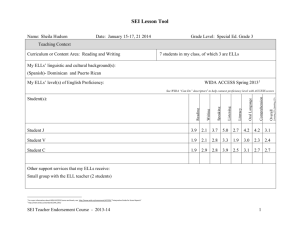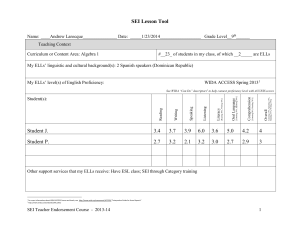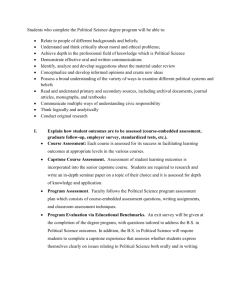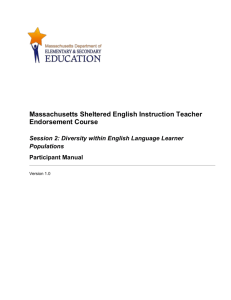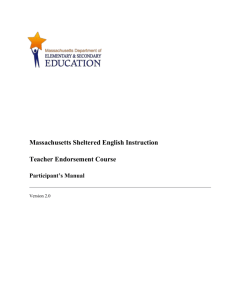Massachusetts SEI Teacher Endorsement Course Short Bridge
advertisement
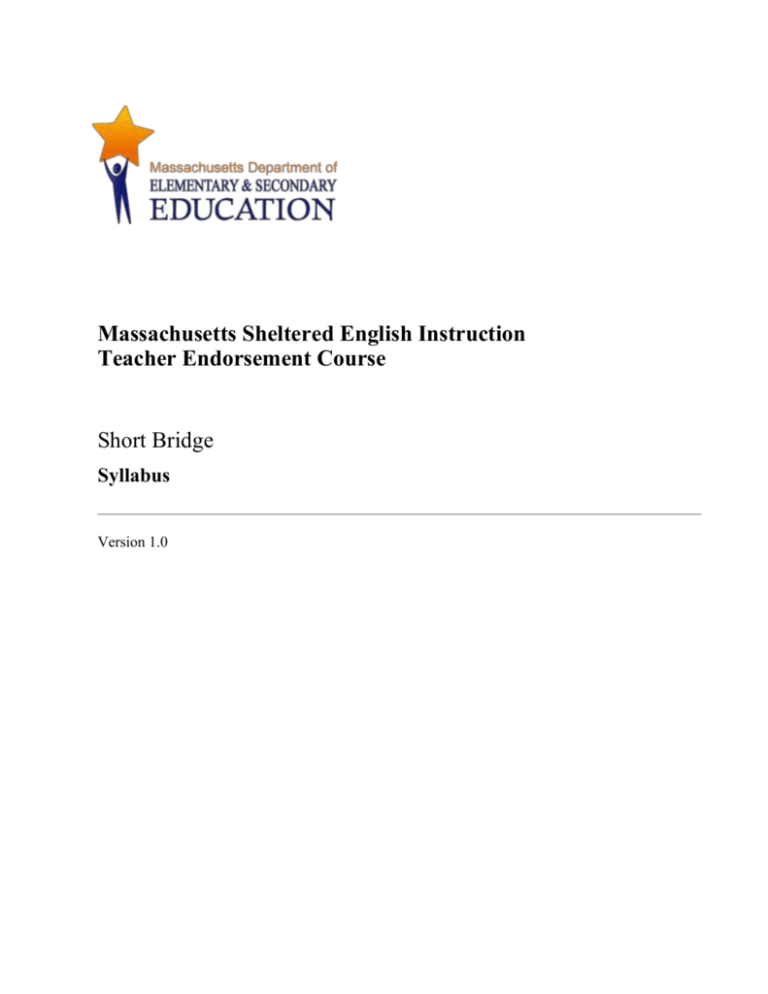
Massachusetts Sheltered English Instruction Teacher Endorsement Course Short Bridge Syllabus Version 1.0 Syllabus Introduction The purpose of this course is to prepare the Commonwealth’s teachers with the knowledge and skills to effectively shelter their content instruction so that our growing population of English language learners (ELLs) can access curriculum, achieve academic success, and contribute their multilingual and multicultural resources as participants and future leaders in the 21st century global economy. The course has three overarching goals: 1. To help teachers effectively carry out their responsibility for the teaching and learning of ELLs as well as to understand the social and cultural issues that contribute to, and, impact the schooling of ELLs. 2. To expand teachers’ knowledge of how language functions within academic content teaching and learning, and how children and adolescents acquire a second language. 3. To provide teachers with practical research-based protocols, methods, and strategies to integrate subject-area content, language, and literacy development—per the expectations of the Massachusetts English Language Development (ELD) World Class Instructional Design and Assessment (WIDA) standards—and thus to support ELL students’ success with the 2011 Massachusetts Curriculum Frameworks for English Language Arts and Literacy and Mathematics and other Massachusetts content standards. Background This SEI Endorsement course, the Administrators’ SEI Endorsement course, and Bridge Endorsement courses for teachers who have taken two or more Category trainings,1 together comprise three key elements of the Commonwealth’s Rethinking Equity and Teaching for English Language Learners (RETELL) initiative. RETELL also includes statewide implementation of the WIDA ELD standards, and the WIDA-ACCESS (Assessing Comprehension and Communication in English State-to-State) assessment tools. Teachers will be introduced to ELD standards and WIDA tools in this course. More information about the RETELL initiative is available at http://www.doe.mass.edu/retell/. All core academic teachers 2 responsible for the education of one or more ELLs are required to earn the SEI Teacher Endorsement between 2012 and 2016, typically through completion of this 1 2 The Department of Elementary and Secondary Education developed the Category training model, which was presented in four sections. Educators who participated in two of the trainings from Categories 1, 2, and 4 are eligible for the SEI endorsement upon completion of a Bridge Course. The SEI Teacher Endorsement course replaces Category Training. The following teachers are classified as “core academic teachers” under the regulations: early childhood and elementary teachers; teachers of students with moderate disabilities; teachers of students with severe disabilities; subject-area teachers in English, reading or language arts; mathematics, science; civics and government, economics, history, and geography. The classification applies to teachers in all Massachusetts public schools, including charter schools and education collaboratives. course. Upon successful completion of the course, participating teachers will receive an SEI endorsement. During the course, these teachers are expected to practice instructional strategies grounded in SEI research both in the endorsement course and in their classrooms. Teachers will also be encouraged to sustain and develop their SEI practices over time through a variety of professional growth opportunities, including the following: • Participation in statewide, online professional learning networks comprised of colleagues in similar roles (e.g., there may be one network group for kindergarten teachers and another for high school biology teachers), facilitated by language acquisition specialists, through which teachers can share resources and strategies for helping ELLs access content standards while developing English language competency. • Existing instructional coaching infrastructure, as part of literacy and mathematics instructional coaching. • Whole-school mechanisms for sustaining focus on ELL needs including collaborative, job-embedded professional learning, promoted in the SEI Administrators’ Endorsement course; • ESE-sponsored SEI conferences; and • Local SEI affinity groups. In many instances, it will also be important for teachers and their evaluators to extend the learning by making SEI the focus of professional practice goals as part of the new educator evaluation process. To support evaluators in this work, ESE is developing a tool, Resource for Evaluating Teachers of ELLs: Support for Understanding the Teacher Rubrics. All educators are also expected to earn at least 15 additional hours of professional development points (PDPs) in SEI or ESL in each licensure renewal cycle beginning July 2016, and these opportunities to extend and sustain learning over time in a developmental way, with increasing experience, will provide an excellent way to meet the licensure renewal requirement. The RETELL initiative and the introduction of this SEI Teachers’ Endorsement course come at a time when teachers of all students, and teachers of ELLs in particular, must be equipped to address the needs and build on the multilingual and multicultural assets of a diverse and everchanging student population in Massachusetts. The introduction of various educational reforms such as the 2011 Massachusetts Curriculum Frameworks for English Language Arts and Literacy and Mathematics, WIDA’s ELD standards, and the Commonwealth’s new educator evaluation system requires teachers to assume new roles and responsibilities in their classrooms. This course will support the professional growth of educators and the teaching and learning of all students in this time of change. The Nature of the Course Like the SEI Teacher Endorsement course, the Short Bridge Endorsement Course focuses on current theories and evidence-based instructional practices related to the teaching of ELLs. This course is designed to promote continuous improvement in educator practice and to build teachers’ confidence and familiarity with research-proven practices for working with ELLs. Throughout the course, teachers have opportunities to practice effective, research-based strategies, to analyze their practice, to provide and receive feedback, and to reflect on their experiences. Through this cycle of reflective practice, teachers build on the skills, knowledge, and dispositions necessary for the education of English learners that they gained in the Category trainings. Assignments are designed to reinforce key concepts and practices. As participants proceed through the course, assignments will include a paper drawing on classroom data and information, classroom tryouts of modeled strategies which teachers will assess using a tool provided for the purpose; and the development, implementation, and presentation of instructional segments. Throughout, participants will be asked to reflect upon the impact of the course material and activities on their practice. The SEI Endorsement course: • Systematically strengthens participants’ capacity to provide SEI through cycles of modeling, practice, and feedback undergirded with current research on effective practice. • Is integrated with and supported by three other major initiatives underway in the Commonwealth: the implementation of the 2011 standards for ELA and math (incorporating the Common Core State Standards), the implementation of WIDA ELD standards for all educators, and the new Educator Evaluation system. • Acknowledges that in addressing the needs of ELLs, individual and collective ownership, collaborative practice between educators, and a whole-school approach are critical. The new SEI endorsement for teachers is cohesively connected to the SEI Administrator Endorsement, and supported by policies that require continuous educator growth over time. • Is facilitated by approved instructors who have been vetted through a comprehensive application and interview process, have participated in a rigorous training program, and will be subject to ongoing performance evaluation. • Is delivered in cohorts across the state. The cohorts will provide opportunities for online and in-district collaboration, peer support, and sharing of ideas and materials. SEI Teacher Course Overview There are a total of 4 face-to-face sessions Session 1 – Introduction and Vocabulary Session 2 – Reading Session 3 – Writing Session 4 – Integration and Capstone Within this structure, the topics of vocabulary and discourse, reading comprehension, and writing instruction are each addressed in four dedicated sessions that build upon one another and culminate in a final instructional integration session. Throughout each of the topics, the lessons explicitly connect strategies across vocabulary and discourse, reading, and writing. By developing these strategies across topics, it enables participants to better apply strategies appropriately and recognize the interconnected nature of these different elements. During the instructional integration session, participants will bring together the strategies learned in vocabulary, reading, and writing and apply this knowledge to the development of an integrated lesson that prepares them for their individual Capstone projects. Course Requirements and Grading Pass/Fail or Letter Grade Option: This course can be taken as either pass/fail or for a grade. If taken pass/fail, participants must obtain the equivalent of an overall course grade of 70% or better to pass. Participants must successfully complete the course to be eligible for the SEI Teacher Endorsement. General Description of Homework Assignments: SEI Endorsement course participants will be expected to attend all classes and participate actively. Participants will complete various preparation assignments including implementation exercises in their classrooms, short papers, lesson reflections, and the capstone project. Each course assignment will be turned in online per directions provided by the instructor. Participants may also be asked to bring assignments into class for discussion. Attendance and Participation: Because the course format depends heavily on class participation and student interaction, it is crucial that participants arrive on time for, come prepared to discuss assigned course readings, having completed all preparation assignments due. Any time participants miss a session, it is their responsibility to review all material presented in class and to complete all assignments prior to the next session. Hardship: If an educator has been assigned to the course and is unable to participate or complete the course due to serious illness or injury, or other circumstances beyond the educator’s control, he or she may ask the Department of Elementary and Secondary Education to grant a hardship exception to allow additional time to meet the requirements for the SEI endorsement. See 603 CMR 14.07(2) (b). For further information, contact retell@doe.mass.edu. Inclement Weather Days and Instructor Absences: In the event that class must be canceled, the instructor will e-mail participants and post an announcement canceling the day’s class on the ESE Endorsement Course page. It will be the participants’ responsibility to check their e-mail or the webpage. Any canceled class will be made up using one of the two extra course dates reserved for such purposes. Categories of Homework Assignments & Grading Weight: Participants will be responsible for different types of assignments during their enrollment in this SEI Endorsement course, in addition to participating in the course. The different types of assignments are designed to provide participants with opportunities to prepare for classroom practice, engage in classroom practice, reflect upon these experiences, participate in critical analysis, and articulate their own learning. Assignments in the Course • Strategy Implementation Assignments (5 assignments) In their own classrooms, participants will implement strategies modeled and practiced in the Endorsement course. Using a Strategy Implementation Report after each implementation, participants will be expected to reflect and report on how their implementation went, both from a practice and from a student-outcome perspective. Throughout the course, participants will have opportunities to discuss these implementation experiences collaboratively with their peers, to share ideas on variations, and to receive feedback from colleagues. • Collaborative Capstone Presentation (1 assignment) The Collaborative Capstone Presentation is intended to be an opportunity to integrate your knowledge and understanding of Sheltered Instruction principles and strategies to design a comprehensive SEI lesson and to prepare for your individual Capstone projects. Individual Capstone Project (1 assignment) The Capstone project will be assigned in the first session and will be due no later than two weeks after the last session of the course. This project involves creating a lesson that integrates SEI instructional strategies to support English language learners. As the course gets underway, participants will be guided through the elements of the project. This will involve developing, delivering and reflecting on the lesson in writing regarding the planning, implementation and refinement for future use. Participation and Collaboration (All sessions) A grade will be given for participation and engagement with colleagues in session. The collaborative discussions of readings, course activities and feedback to colleagues during strategy practice in class plus active participation. Missed classes and/or frequent tardiness will impact the final grade. All grading components will be graded using rubrics. Final course grades will be determined through a combination of grades on assignments and active participation. Overview of Major Assignments and Grading Component of Course Grade 5 Strategy Strategy Implementation Report Implementatio To your classroom instruction, apply practices and n Assignments strategies that were introduced in the session. (30% Grading Each participant will choose a different Rubric ) vocabulary, reading, or writing strategy and be responsible for implementing it and writing up a Strategy Implementation Report using the tool provided in your Participant Manual. You will have an opportunity to practice this strategy multiple times and practice writing a Language Objective for each tryout. The report must be completed after trying out your strategy in the classroom, and you should be ready to discuss your experience with your colleagues and provide feedback to them. You must also post your report online at the course Blackboard site when it is due. Due Post on Blackboard when due: Strategy Implementation Reports: 1 Vocabulary 2 Readings 2 Writing Component of Course Grade 4 Sessions Participation, Discussion & Attendance (40% Grading Rubric) Collaborative Capstone Presentation (5% Grading Rubric) Capstone Project (25% Grading Rubric) Due Attendance will be Participation Participation consists of attendance and active taken at each contributions; completion given during sessions; session. incorporation of knowledge and information from assigned readings into class discussion; collaborative discussion and effective, consistent feedback to colleagues during strategy sessions and lesson presentations. You will participate in Collaborative Capstone Presentation The Collaborative Capstone Presentation is intended the presentation of a to be an opportunity to integrate your knowledge component of your and understanding of Sheltered Instruction group’s Mock principles and strategies to design a Capstone Lesson comprehensive SEI lesson and to prepare for (the product of your your individual Capstone projects. collaboration) to your course colleagues during the final session. Individual Capstone Project The Capstone Project is designed as an opportunity to integrate your knowledge and understandings of Sheltered Instruction principles and strategies to support your students’ content learning and language development. It involves designing, teaching, and reflecting on an integrated SEI lesson that does all of the following: 1) Addresses all four language domains – speaking, listening, reading, and writing 2) Utilizes strategies introduced in the Sheltered English Instruction course 3) Is consistent with the Massachusetts curriculum and WIDA frameworks Please note that depending on your context of teaching, the length of your Capstone Lesson may vary. Participants will need to select one specific class as a focus for this assignment, design a lesson plan utilizing the SEI Lesson Tool, teach this lesson to students in their classroom, and write a reflection on its planning and implementation. Both the lesson and the reflection will be posted on Blackboard no later than two weeks after the Post your individual Capstone Lesson and your reflection on Blackboard no later than two weeks after the last session. Component of Course Grade Due final session. Assignments and Readings Session 1 – Introduction and Vocabulary Assignments Readings Practice 7-Step Process & Tiered Vocabulary strategies in your classroom. Elementary: Calderón, M. 2011. Teaching reading and comprehension to English learners, K-5: Teaching Reading Comprehension and Content, 67-83. Complete a Strategy Implementation Report for the 7Step Process and Tiered Vocabulary. Secondary: Calderón, M. 2007. Teaching reading to English langiage learners, grades 6-12: Vocabulary Development, the foundation for reading in the content areas, 29-45. Complete SEI Lesson Tool page 1 Bring at least one mentor text from your content area to all remaining sessions. Go to www.wida.us from the download library, print and bring the following to the next sessions: Can Do name charts for your grade level Bulletin: Focus on Differentiation Content Objectives: Participants will be able to synthesize and integrate session concepts related to the SEI framework. design language objectives to support their content objectives. implement vocabulary strategies to aid their students’ content learning and language development. Session 2 – Reading Assignments Readings Try out Think-Aloud and Partner Reading strategies Elementary: Calderón, M. 2011. Teaching reading and comprehension to English learners, K-5: Teaching Reading Comprehension and Content, 85103. Complete two Strategy Implementation Reports, one for the Think-Aloud strategy and one for the Partner Reading strategy. Secondary: Calderón, M. 2007. Teaching reading to English langiage learners, grades 6-12: Vocabulary Development, the foundation for reading in the content areas, 47-67. Bring text samples from your content area to the next sessions. Content Objectives: Participants will be able to research and experience reading strategies to address explicit reading comprehension instruction and reflect upon the effectiveness of those strategies. synthesize and identify the relationships among discrete reading skills, background knowledge, and reading comprehension for instructional planning and practice. Session 3 – Writing Assignments Readings Implement two writing strategies of your choice. Gillespie, A. and S. Graham. 2011. Evidence-based practices for teaching writing. Better Evidence-based Education. Baltimore:John Hopkins University. 4-5 Complete Strategy Implementation Reports for each strategy and post on Blackboard. Content Objectives: Participants will be able to analyze SEI writing strategies that help develop control of English language components, structures, conventions, and written discourse based upon their content or curriculum. apply session concepts and strategies in instructional planning and practices. Session 4 – Integration and Capstone Assignments Readings Review course materials & readings to prepare for the Capstone project. None Post individual Capstone Lesson and reflection on Blackboard no later than two weeks after the last session. Content Objectives: Participants will be able to analyze classrooms and texts in order to integrate literacy and academic language instructional strategies and practices into a lesson, with the support of a group. integrate considerations related to classroom, text, and student into a lesson, with the support of a group. provide effective feedback to peers on a practice Capstone lesson. Course Grading Rubrics Strategy Implementation Reports Mechanics Implementation This rubric will be used for all Strategy Implementation Reports and will include feedback from instructors. (30% of final grade; 14 points each; 72/240 points total). Deficient Developing Proficient Distinguished (0 points) Submitted late. Missing or incomplete components. Demonstrates lack of effort to implement targeted strategies or apply central course concepts. Plagiarism. (5 points) Submitted on time. Component or work partially meets expectations. Superficial understanding, analysis and implementation of targeted strategies and limited understanding of course issues. Reflection and revision not evident. (7 points) Submitted on time. Work is complete. Each component, or work as a whole meets expectations. Demonstrates solid understanding, analysis and implementation of targeted strategies and course issues. Shows reflection and thoughtful revision. (9 points) Proficient PLUS work is original and insightful. Demonstrates comprehensive understanding, analysis and implementation of targeted strategies and course concepts with advanced reflection and revision based upon research and self-reflection. Leadership level abilities evident. (0 points) Substantial errors in grammar and formatting that significantly impede understanding of product. Plagiarism. (2 point) Some errors in grammar and formatting. Lacks coherence. (4 points) Well edited. (5 points) Proficient PLUS reaches professional or publishable level. Participation, Discussion & Attendance Classroom Participation (40% of final grade, 24 points each, assessed 4 times = 96/240) Deficient Developing Proficient Distinguished (0 points) Participation does not relate to the topic. No knowledge or understanding is demonstrated regarding concepts and ideas pertaining to the discussion topic. Comments do not support claims with either evidence or argument. Comments contain unsupported opinion. Does not participate. (12 points) Participation minimally relates to topic. Minor knowledge or depth of understanding regarding topics or concepts. Attempts to support claims. (18 points) Participation addresses key issues, questions, or problems related to the discussion or activity, offers some insight, analysis, or observation. Statements apply course concepts. Generally supports claims and opinions with evidence or argument. (24 points) Proficient PLUS original insight, analysis, or observation that demonstrates a comprehensive grasp of concepts and ideas pertaining to the discussion topic or activity. Takes discussion to the next level of understanding. Supports all claims and opinions with either rational argument or evidence. Collaborative Capstone Presentation) Presentation (5% of final grade, 12 points, 12/240) Deficient Developing Proficient Distinguished (0 points) Participant was absent and therefore unable to participate with the group. (6 points) Minimally or superficially participates. Tangentially or insufficiently participates in group practice and feedback. (10 points) Actively participates in mock, practice & feedback session. Relevantly or thoughtfully contributes to the group. Prepared. (12 points) Proficient PLUS shows leadership. Fully prepared for all contingencies. Individual Capstone Lesson and Reflection (25% of final grade, 60 points, 60/240) Planning Mechanics Implementation Deficient Developing Proficient Distinguished (0 points) Submitted late. Missing or incomplete components. Demonstrates lack of effort to implement targeted strategies or apply central course concepts. Plagiarism. (15 points) Submitted on time. Each component, or work as a whole, partially meets expectations. Demonstrates superficial understanding and minimal reflection or planning of targeted strategies as related to the course. (22 points) Submitted on time. Work is complete. Each component/work as a whole meets expectations. Demonstrates solid understanding and reflective planning or analysis for implementation of targeted strategies and course issues. (30 points) Proficient PLUS work is original and insightful. Demonstrates comprehensive understanding, reflection, analysis and implementation of targeted strategies and course concepts. Leadership level abilities evident. (0 points) Substantial errors in grammar and formatting that impede understanding of product. Plagiarism. (2.5 points) Some errors in grammar and formatting. Lacks coherence. (4 points) Well edited. (5 points) Proficient PLUS reaches professional or publishable level. (0 points) Submitted late. Missing or incomplete components. Demonstrates lack of effort to implement targeted strategies or apply central course concepts. Plagiarism. (13 points) Submitted on time. Component or work partially meets expectations. Superficial understanding, analysis and implementation of targeted strategies and limited understanding of course concept. Reflection and revision not evident. (21 points) Submitted on time. Work is complete. Each component, or work as a whole meets expectations. Demonstrates solid understanding, analysis and implementation of targeted strategies and course concepts. Shows reflection and thoughtful revision. (25 points) Proficient PLUS work is original and insightful. Demonstrates comprehensive understanding, analysis and implementation of targeted strategies and course concepts with advanced reflection and revision based upon research and self-reflection. Leadership level abilities evident. Course Readings Vocabulary and Discourse Elementary Calderón, M. 2011. Teaching reading and comprehension to English learners, K–5: Teaching Reading Comprehension and Content, 67-83. Bloomington, IN: Solution Tree Press. Secondary: Calderón, M. 2007. Teaching reading to English language learners, grades 6–12: Vocabulary Development, the foundation for reading in the content areas, 29–45. Thousand Oaks, CA: Corwin Press. Reading Comprehension Elementary Calderón, M. 2011. Teaching reading and comprehension to English learners, K–5.Teaching Reading Comprehension and Content, 85-103. Bloomington, IN: Solution Tree Press. Secondary Calderón, M. 2007. Teaching reading to English language learners, grades 6–12. Chapter 4: Teaching Reading Comprehension and Content, 47-67. Thousand Oaks, CA: Corwin Press. Writing Gillespie, A. and S. Graham. 2011. Evidence-based practices for teaching writing. Better Evidence-based Education. Baltimore: Johns Hopkins University. 4-5

